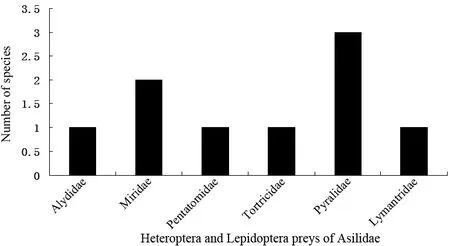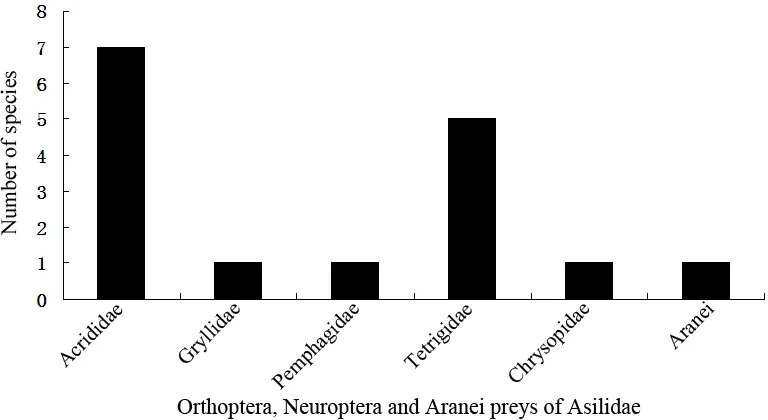伊朗食虫虻(双翅目:食虫虻科)的猎物记录
2014-06-27NajmehSAMINHamidSAKENINHassanGHAHARIRezaMONAEM
Najmeh SAMIN, Hamid SAKENIN, Hassan GHAHARI, Reza MONAEM(. , , , , ; . , , , , )
1 Introduction
Robber flies comprise one of the largest and most abundant families of present day insects. Because of their predatory habit of feeding on other insects and their voravious appetites, they contribute to the maintenance of the natural balance among insect populations(Theodor,1980;Caliskan,2002). To some extent, parasitic wasps and flies are taken by them, but much of their prey consists of plant-feeding insects. Certain species are known to seriously deplete the populations of apiaries(Hull,1962). Shelly(1986)reported that of the nine Neotropical Asilidae species he studied, diet constituents were more than 85% composed of insects from the orders Diptera, Coleoptera, Hymenoptera, Homoptera, and Lepidoptera. Furthermore, larger species tended to consume a greater diversity of prey taxa. Robber flies generally establish a perching zone in which to locate potential prey. Perching height varies by species, but generally occurs in open, sunny locations. Asilidae seize their prey in flight and inject their victims with saliva containing neurotoxic and proteolytic enzymes. This injection, inflicted by their modified mouthparts(hypopharynx), rapidly immobilizes prey and digests bodily contents. The robber fly soon has access to a liquid meal, which is generally consumed upon returning to a perched position(Shurovnekov,1962;Joern and Rudd,1982). Larvae are found in soil and decaying wood, apparently feeding on other insects. They are sometimes found consuming the eggs and larvae of other insects. The swift flying adults are also predators of other insects, catching their prey as it flies through open scrublands. Males often catch females in midair in order to mate. Females oviposit into sand, soil or vegetation(Theodor,1980;Cannings,1998).
Hayat(1997)listed preys of some robber flies in Turkey. Londt(2006)listed 2000 prey record for Afrotropical Asilidae. Dennis and Lavigne(2007)analyzed hymenopteran preys of Asilidae and listed many new records of Hymenoptera as the preys of Asilidae. The impressive work about asilids' preys was produced by Dr. Robert Lavigne as Predator-Prey Database(Lavigne,2005). Of the approximate 58,024 preys are listed in the database. All the world literatures on Asilidae(1996-2006)were listed by Ghaharietal.(2007)which this impressive work facilitates to obtain the papers on the subject.
Iran forms a large part of the Iranian plateau, and covers an area of 1,623,779 km2. It is bordered in the north by the Caucasus Mts., Middle Asian natural regions and the Caspian Sea(-27 m below sea level); inthe west by the Anatolian and Mesopotamian regions; in the east by the eastern part of the Iranian plateau(Afghanistan and adjacent west Pakistan)and the Baluch-Sindian region; and finally in the south by the Persian Gulf and Oman Sea, which are connected by the latter to the Indian Ocean(Zehzadetal., 2002).
Asilidae is known to have 1634 species at Palaearctic region(Lehr,1988;Geller-Grimm,2005). The fauna of Iranian Asilidae was studied very well and totally 236 species were identified so far(Abbassian-Lintzen,1964a,b;Lehr,1988;Lehretal.,2007;Ghaharietal.,2007a,b,c,2008a,b,2009;Hayatetal.,2008;Saghaeetal.,2008,2009;Tomasovic and Saghaei,2009;Saminetal.,2010,2011;Ostovari and Rastegar,2013). Basis of several samplings in different regions of Iran and visiting many Entomology collections and the museums of different countries, we estimate that totally 350-400 asilid species and subspecies present in Iran.
2 Results
The result indicates that Iranian robber flies are the efficient predators of 130 insect species in 7 orders and 37 families, and also one Aranei species. Among the diverse preys of Asilidae in different taxa, Hymenoptera(53 species), Diptera(34 species), Coleoptera(18 species), Orthoptera(14 species), Lepidoptera(5 species), Heteroptera(4 species), Neuroptera and Aranei(one species)have the highest number of species preys, respectively(Fig.1). The orders contain the preys are separately discussed below.
Order Coleoptera
In a total of 21 species from 7 families including Chrysomelidae(2 species), Coccinellidae(3 species), Curculionidae(5 species), Malachiidae(4 species), Melyridae(1 species), Scarabaeidae(1 species)and Tenebrionidae(2 species)were determined as the preys of Iranian Asilidae(Fig.2)

Figure 1 Total preys of Asilidae in Iran

Figure 2 Coleoptera preys of Asilidae in Iran
Order Diptera
Of the seven families including Bibionidae(1 species), Calliphoridae(2 species), Muscidae(2 species), Sarcophagidae(6 species), Syrphidae(6 species), Tabanidae(15 species), Tachinidae(2 species), totally 34 preys were identified(Fig.3).
Order Heteroptera
Four species from three families Alydidae(1 species), Miridae(2 species)and Pentatomidae(1 species)were determined(Fig.4).

Figure 3 Diptera preys of Asilidae in Iran

Figure 4 Heteroptera and Lepidoptera preys of Asilidae in Iran
Order Hymenoptera
Totally 53 species of 12 families including Anthophoridae(1 species), Andrenidae(2 species), Apidae(4 species), Cephidae(1 species), Crabronidae(5 species), Evaniidae(3 species), Halictidae(1 species), Formicidae(1 species), Melittidae(1 species), Ichneumonidae(3 species), Sphecidae(16 species)and Vespidae(15 species)were determined as the preys of Iranian robber flies(Fig.5).
Order Lepidoptera
Among the three families including Tortricidae(1 species), Pyralidae(3 species)and Lymantridae(1 species), totally six species were identified(Fig.4).
Order Orthoptera
Totally 14 species from four families including Acrididae(7 species), Gryllidae(1 species), Pemphagidae(1 species)and Tetrigidae(5 species)were determined(Fig.6)
Order Neuroptera and class Aranei
One species for each of these two taxa were collected as asilids' prey(Fig.6). There are approximately 43,000 described species of spiders(Araneae)(Platnick, 2011)that are found worldwide on every continent except Antarctica. Because robber flies(Diptera: Asilidae)are opportunistic predators that also can be found in many similar habitats, one would expect spiders to serve as prey in proportional numbers to other arthropod prey(Dennisetal.,2012).

Figure 5 Hymeoptera preys of Asilidae in Iran

Figure 6 Orthoptera, Neuroptera and Aranei preys of Asilidae in Iran
3 Discussion
In this paper 130 preys are listed for 104 asilids of 38 genera while the total of Iranian asilids has been reached to over than 270 species so far. This means that research on this topic must be continued and will be resulted to very interesting data about the preys of Iranian robber flies. Londt(2006)listed 527 Hymenoptera species, 457 Diptera species, 294 Coleoptera species, 280 Orthoptera species, 191 Hemiptera species, 163 Lepidoptera species and 25 Neuroptera species as the preys of Asilidae in Afrotropical region. Iran is a large country with different geographical regions and climate; therefore more diverse robber flies and their preys are expected in this part of Palaearctic. In this paper,Stenopogon,Dioctria(11 species),Dysmachus(10 species),Machimus(8 species),Choerades,Eutolmus,Heteropogon,Pycnopogon,Promachus(4 species)andHabropogon,Laphria,Leptogaster(3 species)have the highest species diversity as the predators of insects. Although there are diverse fauna of robber flies in Iran as the powerful predators, but since they are general predators, attack and eat several beneficial insects together with pests; therefore they can not be important and efficient agents in biological control programs. However, these dipteran flies are beneficial organisms in different ecosystems and therefore must be conserved besides of other natural enemies. Conservation biological control involves manipulation of the environment to enhance the survival, fecundity, longevity, and behavior of natural enemies to increase their effectiveness. Such conservation efforts may be directed at mitigating harmful conditions or enhancing favorable ones. Conservation practices can be further categorized as those that focus on reducing mortality, providing supplementary resources, controlling secondary enemies, or manipulating host plant attributes to the benefit of natural enemies(van den Bosch and Telford,1964). Because of its importance in enhancing natural enemy performance, conservation biological control should be a keystone of all biological control efforts(Gurr and Wratten,1999). Of the major forms of biological control, conservation biological control has received the least amount of attention(Landisetal.,2000).
Although the fauna and prey records of Asilidae were studied in different regions of the world very well, the biology and ethology of these predators were studied very poorly. Studying on this topic will be resulted to very new and interesting data on Asilide. Hayat and Caliskan(2003)studied the ethology ofDasypogonirinelaein Turkey. Since robber flies are very interesting insects with unknown bioecology, working on this topic can be suggested main work by researchers.
Acknowledgement
The authors thank Dr. J. Huang(Fujian Agriculture and Forestry University, China)for editorial assistance and review of this paper. We are grateful to Dr. R. Hayat(Suleyman Demirel University, Turkey), Dr. R. Lavigne(South Australia Museum, Australia), Dr. F. Geller-Grimm(Museum Wiesbaden, Hessisches Landesmuseum für Kunst und Natur, Germany)and Dr. A. Scarbrough(Towson State University, USA)for providing of necessary papers. The research was supported by Islamic Azad University(Shahre Rey and Qaemshahr Branches).
Abbassian-Lintzen R.1964a.Asilidae(Diptera)of Iran.I.Robber flies belonging to the subfamilies Laphriinae and Dasypogoninae(with description of new species).Annals and Magazine of Natural History,London,13:417-435.
Abbassian-Lintzen R.1964b.Asilidae(Diptera)of Iran.II.Notes on the genus Eremisca Zin.and description of E.schahgudiani n.sp.Annals and Magazine of Natural History,London,13:547-552.
Caliskan H.2002.Investigations on the Asilidae(Diptera)fauna of Eskisehir province.Anadolu University Journal of Science and Technology,3(2):318-327.
Cannings RA.1998.Robber flies(Insecta:Diptera:Asilidae).http://www.eman-rese.ca/eman/reports/publications/99_montane/robber_f/intro.html(15 July 2002).
Dennis DS,Lavigne RJ.2007.Hymenoptera as Prey of Robber Flies(Diptera:Asilidae)with New Prey Records.Journal of Entomological Research Society,9(3):23-42.
Dennis DS,Lavigne RJ,Dennis JG.2012.Spiders(Araneae)as prey of robber flies(Diptera:Asilidae).Journal of Entomological Research Society,14(1):65-76.
Geller-Grimm F.2005.Robber Flies(Asilidae)Database,Species,http://www.geller-grimm.de/catalog/species.htm,March 13,2005.
Ghahari H,Lavigne RJ,Geller-Grimm F.2007a.Bibliography of Asilidae(Insecta:Diptera),1996 -2006.Far Eastern Entomologist,173:1-39.
Ghahari H,Lehr PA,Lavigne RJ,Hayat R,Ostovan H.2007b.New records of robber flies(Diptera:Asilidae)for the Iranian fauna with their prey records.Far Eastern Entomologist,179:1-9.
Ghahari H,Hayat R,Lavigne RJ,Ostovan H.2007c.Robber flies(Diptera:Asilidae)of Iranian rice fields and surrounding grasslands.Linzer biologische Beiträge,39(2):919-928.
Ghahari H,Hayat R,Chao C-M,Ostovan H.2008.A contribution to the Dipteran parasitoids and predators in the Iranian cotton fields and surrounding grasslands.Munis Entomology and Zoology,3(2):699-706.
Ghahari H,Hayat R,Tabari M,Ostovan H,Imani S.2008a.A contribution to the predator and parasitoid fauna of rice pests in Iran,and a discussion on the biodiversity and IPM in rice fields.Linzer biologische Beiträge,40/1:735-764.
Ghahari H,Ostovan H,Kamali K,Tabari M.2008b.Arthropod predators of rice fields in central parts of Mazandaran.Journal of Agricultural Science(Islamic Azad University),14(1):63-74 [In Persian,English summary].
Ghahari H,Havaskary M,Tabari M,Ostovan H,Sakenin H.2009.An annotated catalogue of Orthoptera(Insecta)and their natural enemies from Iranian rice fields and surrounding grasslands.Linzer biologische Beiträge,41/1:639-672.
Gurr GM,Wratten SD.1999.Integrated biological control:a proposal for enhancing success in biological control.International Journal of Pest Management,45:81-84.
Hayat R.1997.Prey of some robber flies(Diptera:Asilidae)in Turkey.Zoology in the Middle East,15:87-94.
Hayat R,Caliskan H.2003.Ethology of the robber fly Dasypogon irinelae Weinberg,1986(Diptera,Asilidae).Zoology in the Middle East,30:91-94.
Hayat R,Ghahari H,Lavigne RJ,Ostovan H.2008.Iranian Asilidae(Insecta:Diptera).Turkish Journal of Zoology,32:175-195.
Hull FM.1962.Robber flies of the world the genera of the family Asilidae.Smithsonian Institution.Uited States National Museum,224(1-2),907 pp.Washington.
Joern A,Rudd NT.1982.Impact of predation by the robber fly Proctacanthus milbertii(Diptera:Asilidae)on grasshopper(Orthoptera:Acrididae)populations.Oecologia,55:42-46.
Khajehzadeh Y.2004.Investigation on the grasshoppers and their natural enemies in Khuzestan province.In:Proceeding of 16th Iranian Plant Protection Congress,p.93.
Landis DA,Wratten SD,Gurr GM.2000.Habitat management to conserve natural enemies of arthropod pests in agriculture.Annual Review of Entomology,45:175-201.
Lavigne RJ.2005.Predator-prey database for the family Asilidae(Hexapoda:Diptera).Available from http://www.geller-grimm.de/catalog.lavigne.htm.
Lehr PA.1988.Asilidae.In:Catalogue of Palearctic Diptera(eds.A.Soos,L.Papp).Elsevier Science Publishing Amsterdam,pp.197-326.
Lehr PA,Ghahari H,Ostovan H.2007.A contribution to the robber flies of subfamilies Stenopogoninae and Asilinae(Diptera:Asilidae)from Iran.Far Eastern Entomologist,173:1-14.
Londt JGH.2006.Predation by Afrotropical Asilidae(Diptera):an analysis of 2000 prey records.African Entomology,14(2):317-328.
Ostovari H,Rastegar J.2013.A study on the robber flies(Diptera:Asilidae)from Khorasan and Semnan provinces,Iran.Calodema,243:1-4.
Platnick NI.2011.The world spider catalog,Version 12.0.American Museum of Natural History.Available from http://research.amnh.org/iz/spiders/catalog/(accessed 13 December 2011).
Saghae N,Ostovan H,Shojai M.2008.A faunistic study of robber flies(Asilidae)in Fars province.Proceedings of 18th Iranian Plant Protection Congress,p.88.
Saghae N,Ostovan H,Shojaii M,Hayat R.2009.Introduction to the Asilidae Fauna(Insecta:Diptera)of Fars Province,Iran.Turkish Journal of Zoology 33:187-200.
Samin N,Sakenin H,Imani S,Shojai M.2010.A contribution to the knowledge of robber flies(Diptera:Asilidae)from Tehran province and vicinity,Iran.Journal of Biological Control,24(1):42-46.
Samin N,Sakenin H,Imani S.2011.A contribution to the knowledge of robber flies(Diptera:Asilidae)from some regions of Iran.Calodema,159:1-5.
Shelly TE.1986.Rates of prey consumption by Neotropical robber flies(Diptera:Asilidae).Biotropica,18:166-170.
Shurovnekov BG.1962.Field entomophagous predators(Coleoptera,Carabidae,and Diptera,Asilidae)and factors determining their efficiency.Entomological Review,41:476-485.
Theodor O.1980.Diptera:Asilidae.Fauna Palaestina,Insecta II.Israel Academy of Sciences & Humanities,Jerusalem.
Tomasovic G,Saghaei N.2009.Contribution to the knowledge of the Asilidae(Diptera:Brachycera)from Fars province(Iran).Faunistic Entomology,62(2):45-56.
van den Bosch R,Telford AD.1964.Environmental modification and biological control.In:Biological control of pests and weeds,(ed.)P.De Bach,pp.459-88.New York:Reinhold.
Zehzad B,Kiabi BH,Madjnoonian H.2002.The natural areas and landscape of Iran:an overview.Zoology in the Middle East,26:7-10.
